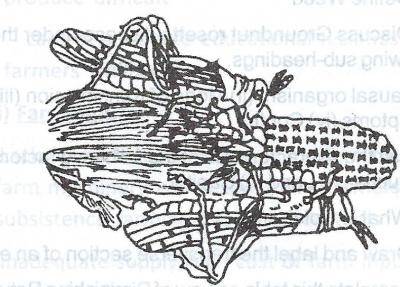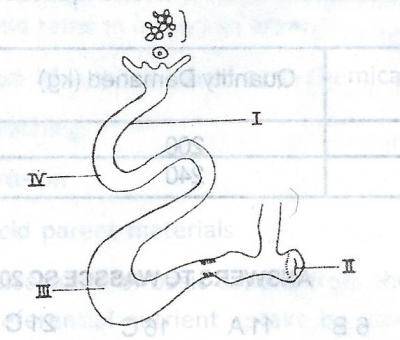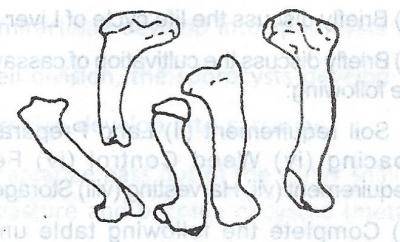Year :
2018
Title :
Agricultural Science
Exam :
WASSCE/WAEC MAY/JUNE
Paper 1 | Objectives
31 - 40 of 50 Questions
| # | Question | Ans |
|---|---|---|
| 31. |
 The diagram above illustrates a crop pest. What kind of pest is this? A. A boring insect pest B. A chewing insect pest C. A sucking insect pest D. A piercing insect pest |
B |
| 32. |
 The diagram above is a crop pest. A cultural method used in controlling the pest illustrated is A. spraying with insecticides B. hand-pulling of weeds C. fumigation of store D. early planting |
A |
| 33. |
 In the diagram of the digestive tract of a farm animal illustrated above, deamination is a function of the part labelled A. I B. II C. III D. IV |
D |
| 34. |
The diagram above illustrates the digestive tract of a farm animal. Digestion of protein starts in the part labelled A. I B. II C. III D. IV |
A |
| 35. |
 In the diagram illustrated above, fertilization takes place in the part labelled A. I B. II C. III D. IV |
A |
| 36. |
In the diagram illustrated above, chalaza is formed in the part labelled A. I B. II C. III D. IV |
D |
| 37. |
A farmer observed that all his day-old chicks clustered around the source of heat in a brooder house. This observation is likely due to A. manifestation of a disease outbreak B. thirst because of inadequate water C. poor nutrition D. low temperature |
D |
| 38. |
Which of the following practices ensures that a young animal has resistance against diseases? A. Regular visits to the veterinary doctors B. Giving the animal a maintenance ration C. Regular dipping of animal D. Giving the animal access to colostrums |
D |
| 39. |
 The animal by-product illustrated in the diagram above may be prepared and fed to farm animals as a source of A. sodium B. iron C. calcium D. nitrogen |
C |
| 40. |
 The animal by-product illustrated in the diagram above is not used in making A. fertilizer B. bone meal C. button D. leather |
D |
| 31. |
 The diagram above illustrates a crop pest. What kind of pest is this? A. A boring insect pest B. A chewing insect pest C. A sucking insect pest D. A piercing insect pest |
B |
| 32. |
 The diagram above is a crop pest. A cultural method used in controlling the pest illustrated is A. spraying with insecticides B. hand-pulling of weeds C. fumigation of store D. early planting |
A |
| 33. |
 In the diagram of the digestive tract of a farm animal illustrated above, deamination is a function of the part labelled A. I B. II C. III D. IV |
D |
| 34. |
The diagram above illustrates the digestive tract of a farm animal. Digestion of protein starts in the part labelled A. I B. II C. III D. IV |
A |
| 35. |
 In the diagram illustrated above, fertilization takes place in the part labelled A. I B. II C. III D. IV |
A |
| 36. |
In the diagram illustrated above, chalaza is formed in the part labelled A. I B. II C. III D. IV |
D |
| 37. |
A farmer observed that all his day-old chicks clustered around the source of heat in a brooder house. This observation is likely due to A. manifestation of a disease outbreak B. thirst because of inadequate water C. poor nutrition D. low temperature |
D |
| 38. |
Which of the following practices ensures that a young animal has resistance against diseases? A. Regular visits to the veterinary doctors B. Giving the animal a maintenance ration C. Regular dipping of animal D. Giving the animal access to colostrums |
D |
| 39. |
 The animal by-product illustrated in the diagram above may be prepared and fed to farm animals as a source of A. sodium B. iron C. calcium D. nitrogen |
C |
| 40. |
 The animal by-product illustrated in the diagram above is not used in making A. fertilizer B. bone meal C. button D. leather |
D |